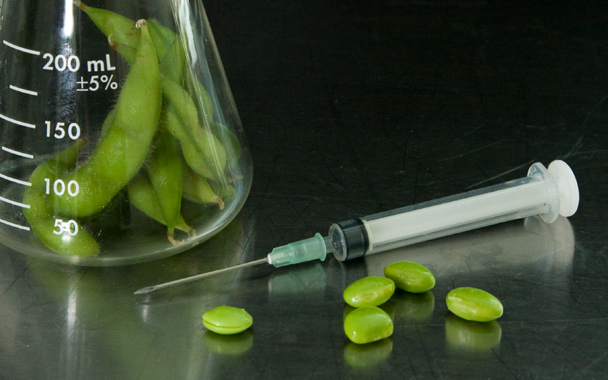Debunking Yet Another GM Myth
Those singing the praises of genetically modified (GM) crops often tout increased yields as one of the advantages to growing them. Two important studies say otherwise. Barney Gordon of Kansas State University reports in a recent issue of the journal Better Crops that his test plots of GM soybeans (which make up 90 percent of the soybeans grown in this country) produced 10 percent fewer beans than conventional crops. He suspects that the bioengineered beans do not absorb magnesium, an element essential to photosynthesis, as well as non-GM plants. An earlier study from the University of Nebraska produced similar results.
Higher yields is the second GM myth to be busted this year. Modified crops were also supposed to reduce the use of pesticides. But a report earlier this year by Friends of the Earth International showed that applications of glyphosate, an insecticide, and 2,4-D and atrazine, both herbicides, have increased dramatically in the United States in the dozen years since GM seeds were first sown in farmers’ fields.
More Good News…
…for those of us trying to eat animals raised and killed in a humane manner: The formidable Pew Commission on Industrial Farm Animal Production released a report this week calling for an end to intensive confinement practices on American farms. The list of unacceptable living quarters includes gestation crates for sows; veal crates; and battery cages for laying hens.
Commission members include such influential luminaries as former U. S. Secretary of Agriculture Dan Glickman; former Kansas governor John Carlin; and the former Dean of the University of Tennessee’s College of Veterinary Medicine, Michael Blackwell. This is not a group of animal rights extremists, to be sure.
A few weeks ago, an act to ban confinement practices qualified for the ballot in California. Florida, Arizona, and Oregon have prohibited gestation crates. Arizona also disallows veal crates. Who knows, we may be catching up to the rest of the civilized world: The European Union has already legislated against the “Big Three” confinement abuses.
Better Butchering
Grass-fed beef has a lot going for it. The cattle that produce it spend their days on pastures eating grass like they are supposed to—unlike feedlot cattle, which live in crowded pens for the last several months of their lives, stuffing themselves with corn-based feed (and a whole lot of drugs to counteract the ill effects of that corn, which isn’t part of a cow’s natural diet). But the differences between the two types of cows end at the last crucial stage of their lives. Due to a shortage of slaughterhouses, many grass-fed cattle are herded into trailers and trucked vast distances to the same large, inhumane, and dirty plants that process their industrially raised counterparts.
That may be changing. Two conscientious beef farmers on opposite sides of the country have opened their own slaughterhouses. In Bluffton, GA, White Oak Pastures, the state’s largest grass-fed beef producer, has just completed its own on-farm plant, according to Sustainable Food News. The plant was designed by Dr. Temple Grandin, an expert on the humane treatment of animals. A similar facility was opened earlier this year by Sallie Calhoun, owner of Paicines Ranch, a grass-fed cattle operation in Benito County, CA.
In addition to handling the production from their owners’ fields, both of the new boutique abattoirs will provide a valuable service to other small, local, sustainable growers, who until now had to truck their animals great distances, and whose output was not limited by demand (it’s soaring) but by the capacity of processing plants.


